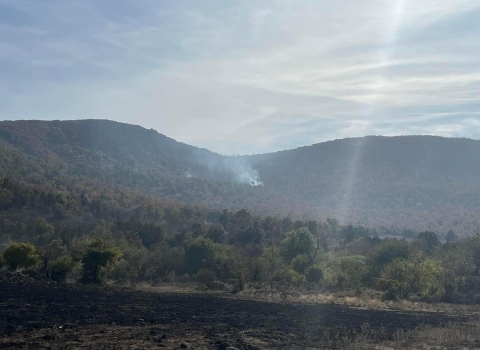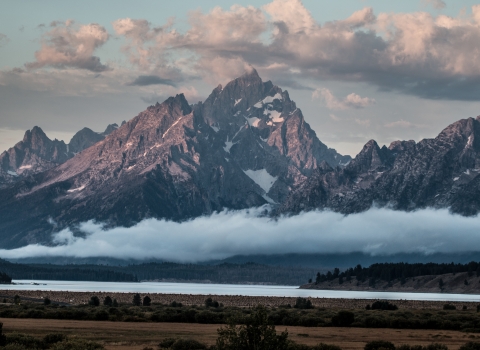WASHINGTON – Today, the Department of the Interior announced that 40 fish passage fish passage
Fish passage is the ability of fish or other aquatic species to move freely throughout their life to find food, reproduce, and complete their natural migration cycles. Millions of barriers to fish passage across the country are fragmenting habitat and leading to species declines. The U.S. Fish and Wildlife Service's National Fish Passage Program is working to reconnect watersheds to benefit both wildlife and people.
Learn more about fish passage projects in 23 states and Puerto Rico will receive a total of nearly $38 million in fiscal year 2022 funding from President Biden’s Bipartisan Infrastructure Law Bipartisan Infrastructure Law
The Bipartisan Infrastructure Law (BIL) is a once-in-a-generation investment in the nation’s infrastructure and economic competitiveness. We were directly appropriated $455 million over five years in BIL funds for programs related to the President’s America the Beautiful initiative.
Learn more about Bipartisan Infrastructure Law . With a total of $200 million in investments in the National Fish Passage Program over the next five years, the Bipartisan Infrastructure Law will bolster efforts to address outdated, unsafe or obsolete dams, culverts, levees and other barriers fragmenting our nation’s rivers and streams, which will help restore fish passages and aquatic connectivity.
The National Fish Passage Program, facilitated by the U.S. Fish and Wildlife Service, supports aquatic ecosystem restoration projects and restores free-flowing waters, allowing for enhanced fish migration and protecting communities from flooding.
MORE: Bipartisan Infrastructure Law Funds Proven Projects for Fish and Wildlife
“Across the country, millions of barriers block fish migration and put communities at higher risk of flooding,” said Secretary Deb Haaland. “President Biden’s Bipartisan Infrastructure Law provides a once-in-a-generation opportunity to invest in our nation’s rivers, streams and communities and help restore habitat connectivity for aquatic species around the country.”
Several of the projects receiving funding will directly address issues related to climate change climate change
Climate change includes both global warming driven by human-induced emissions of greenhouse gases and the resulting large-scale shifts in weather patterns. Though there have been previous periods of climatic change, since the mid-20th century humans have had an unprecedented impact on Earth's climate system and caused change on a global scale.
Learn more about climate change and serve disadvantaged communities, while also spanning the nation geographically and addressing a wide array of diverse aquatic resource issues.
As part of today's announcement, Assistant Secretary for Fish and Wildlife and Parks Shannon Estenoz and Service Director Martha Williams visited the Albright Power Station Dam near Albright, West Virginia, which is among the recipients of the new funding. During the visit, the leaders met with staff and partners to discuss the dam’s removal and the positive impact it will have on neighboring communities. Removing the obsolete dam, built in 1952 on the Cheat River, will help increase public access and recreational opportunities and improve public safety. Engineering is underway, and removal is planned for 2023.
“Aquatic restoration projects funded by the Bipartisan Infrastructure Law are important examples of how nature-based projects can enable ecosystems and communities to be more resilient to climate change,” said Service Director Williams. “In addition to providing benefits for fish and aquatic species, the National Fish Passage Program’s work to restore degraded and fragmented aquatic habitats decreases public safety hazards, improves infrastructure resilience, and creates jobs, stimulating the local economy.”
The National Fish Passage Program has decades of proven experience implementing infrastructure projects with partners to improve the health of the nation’s waterways, reconnect rivers, improve climate resilience, and enhance local economies. The program provides financial, engineering and planning assistance to communities, Tribes and landowners to help remove barriers and restore rivers for the benefit of fish and people.
Since 1999, the program has worked with over 2,000 local communities, states, Tribes and private landowners to remove or bypass 3,202 barriers to fish passage and reopen access to 57,736 miles of upstream habitat and 193,783 acres of wetland habitat for fish and other animals.
The rivers, streams and coastal systems of the North America once supported vast annual runs of fish such as Atlantic salmon, American shad, alewife, blueback herring and American eel. These species and many others, including some at-risk and listed species, depend on connected streams and high-quality habitat to survive.
During the past 200 years, many of these populations have decreased drastically, in large part due to the proliferation of barriers like dams and undersized culverts and watershed development that blocks fish from their natural migrations.
For more information about the National Fish Passage Program and the 40 BIL-funded projects, please visit the Service’s Fish Passage Program website.
Enhancing wildlife corridors and habitat connectivity, including fish passage, is an early focus of the Biden-Harris administration’s America the Beautifulinitiative. Today’s announcement comes on the heels of Monday’s launch of a separate $1 billion America the Beautiful Challenge that will leverage federal conservation and restoration investments with private and philanthropic contributions to accelerate locally led land, water and wildlife conservation efforts across the country.
The U.S. Fish and Wildlife Service works with others to conserve, protect and enhance fish, wildlife, plants and their habitats for the continuing benefit of the American people. For more information, visit www.fws.gov, or connect with us through any of these social media channels: Facebook, Twitter, Flickr, YouTube.

